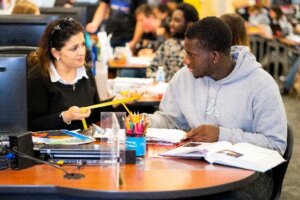
Most of the students who come to us are behind in credits because they weren’t successful in their previous school. Not all students do well in a large classroom with the teacher giving the same lecture to everyone. The kids who are more advanced get bored, and those who need a little help fall behind.
According to Shellie Hanes, school superintendent, the first step is a thorough assessment to determine what their learning style is and where they need help. They may have a learning disability that needs to be addressed, or perhaps they missed a lot of school because they need to work or take care of a baby.
“Once we know what obstacles are keeping them from learning, the teachers, tutors and school counselors can develop a plan just for them,” she explained. “They might be good readers but struggle in math, so we provide free tutoring in math as they progress in reading to build their confidence. Or we work with their schedule to allow them to get their assignments done off campus and just meet with their teachers a few times a week.”
Hanes said that equally important is assessing a student’s social and emotional needs. Have they been bullied? Are they dealing with a difficult family situation? Homeless, fostered, pregnant or dealing with poverty?
“All these types of long-term trauma definitely interfere with a child’s ability to learn,” she explained. “We focus on first removing barriers in the way of learning and then we work on building resiliency.” She points out that all the school staff members are trained in a trauma-informed approach to education that helps kids learn resiliency.
